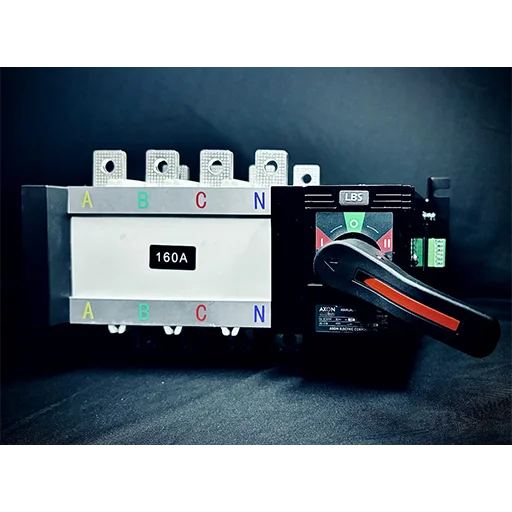
A Manual Transfer Switch (MTS) is an electrical device that allows for the safe and easy manual switching between two power sources, usually between utility power and a backup generator. Since it requires manual operation, it is referred to as a manual transfer switch. It is commonly used in residential, commercial, and industrial settings to switchover to backup power during utility power outages
Purpose :
The main purpose of a Manual Transfer Switch is to allow users to switch between the utility power and a backup power source (e.g., generator) without risking electrical hazards or back feeding power into the grid. It provides a safe and reliable way to manage power sources during emergencies or planned maintenance.
Design :
A Manual Transfer Switch typically consists of a sturdy and durable enclosure housing a double-throw switch or a combination of multiple switches. The enclosure is usually made of non-metal and is rated to meet electrical safety standards. The switches are manually operated, which means they require human intervention to change the power source.
Operation :
A manual transfer switch connects a building’s electrical circuits to a backup generator. In the event of a power outage, the operator manually switches to the backup power source, allowing connected circuits to receive power from the generator. This switch can be used both indoors and outdoors. The number of circuits that can be connected depends on the generator’s output. When utility power is restored, the switch enables electricity to flow from the utility to the electrical panel, supplying power to the building’s circuits. During a power outage, the switch is manually moved to the “Generator” position, which disconnects the utility power and connects the backup generator to the electrical panel, providing power to the circuits.
Circuit Diagram of Manual Transfer Switch

The handle of a manual transfer switch can be operated in three positions: Source 1, Source 2, and Off. When the handle is moved to the Off position, the load is completely isolated from any power source. Shifting the handle to Source 1 connects the load to power Source 1 while disconnecting it from Source 2. Conversely, moving the handle to Source 2 switches the load to Source 2, disconnecting it from Source 1.
Pros and Cons
The advantages of a manual transfer switch include:
- Cost-effective design and installation.
- Compact size.
- It doesn’t require any control cables.
- This switch has high short-circuit withstand capability
- Fixed make and brake operation.
- Rugged design.
- It works in compact environmental circumstances
The disadvantages of a manual transfer switch include:
- Not suitable for applications requiring an immediate power switch, regardless of human availability.
- Requires manual operation.
- The generator must be started manually each time.
- Human interference to connect a temporary power supply compared to an automatic transfer switch.
- Builtin protection system is not provided
Safety :
Manual Transfer Switches are designed to prevent simultaneous connections between the utility and generator sources, which could lead to dangerous back feeding situations. Back feeding occurs when electrical power flows from a generator back into the utility lines, endangering utility workers and neighboring properties.
Capacity :
The Manual Transfer Switch’s capacity should match the electrical load requirements of the building or circuits it serves. It is crucial to ensure that the switch can handle the total electrical load to avoid overloading and potential equipment damage.
Professional Installation :
Installing a Manual Transfer Switch should be done by a qualified electrician. Proper installation is essential to ensure safety, compliance with electrical codes, and proper functionality during power transfers.
Maintenance :
Regular maintenance and testing of the Manual Transfer Switch are vital to ensure its reliability during an actual power outage. It’s essential to follow the manufacturer’s guidelines for maintenance and schedule periodic inspections.
Applications
Applications of a manual transfer switch include:
- Ensuring lights and essential systems remain powered during emergencies or temporary outages.
- Used in buildings and industries such as manufacturing and automotive.
- Allows operators to activate a generator and restore power to designated circuits when utility power fails.
Key Benefits of a Manual Transfer Switch
- Uninterrupted Power Supply – Ensures seamless transition between utility and backup power, minimizing downtime.
- Cost-Effective Solution – More affordable than automatic transfer switches, making it an ideal choice for residential and small business use.
- Ease of Installation – Simple setup process compared to complex alternatives, reducing installation costs and time. Designed for quick setup with simple manual controls, making it accessible for both homeowners and businesses.
- User Control & Flexibility – Allows users to manually select which circuits receive backup power, optimizing energy use.
- Enhanced Safety – Prevents back feeding, reducing risks of electrocution or damage to the electrical grid. Protects utility workers and electrical systems by preventing dangerous electrical backflow into the grid. Reduces risks of electrocution, equipment damage, and fire hazards during power transitions.
- Durability & Reliability – Built to withstand heavy use, ensuring long-term performance during power outages.
- Compliance with Electrical Codes – Meets safety regulations and standards, ensuring legal and safe operation.
- Compatibility with Various Generators – Works with a wide range of generator brands and sizes for added versatility.
- Low Maintenance Requirements – Unlike automatic switches, manual transfer switches require minimal upkeep, saving time and money.
- Peace of Mind – Ensures preparedness during emergencies, keeping essential appliances and systems operational.
- Reliable Power Backup – Ensures a smooth transition to generator power during outages, keeping essential appliances and systems running.
- Durability & Longevity – Built with robust materials to withstand frequent use and harsh weather conditions.
- Legal Compliance – Meets national electrical codes, ensuring safe and approved backup power switching.
- Versatility – Compatible with different generator types and power capacities, offering flexibility in emergency preparedness.
Manual Transfer Switch Vs Automatic Transfer Switch
The key differences between a manual transfer switch and an automatic transfer switch are as follows.
| Manual Transfer Switch | Automatic Transfer Switc0068 |
| Manual transfer switches are very reasonable & simplistic. | Automatic transfer switches are relatively expensive. |
| These switches require manual operation, meaning an operator must be present to operate them. | These switches operate automatically. |
| Auto start/stop of generator is not possible in case of MTS | Auto start/stop of generator is possible in case of ATS |
| This switch requires technical skills to operate. | This switch doesn’t require technical skills. |
| Protection systems like under / Over Voltages , Under or Over Frequency, Phase sequence Error or Over load protections cannot be built in | Protection systems like under / Over Voltages, Under or Over Frequency , Phase sequence Erreor or over load protections can be built in. |
| Switching Delay Between Transfer and Recovery is manually decided | Switching delay between Auto Transfer and Auto recovery can be preset for optimum utilization. |
| Manual switching delays decrease productivity and increase downtime. | Automatic switching increases power availability and decreases downtime. |
| Less safer than ATS as manual intervention is involved. | Safer than MTS as no manual intervention is involved. |
| MTS has advantage of having extended rotary handle to be mounted on the door. | In Automatic transfer switch extended rotary handle cannot be provided |
| Remote operation is not possible | Remote operation is possible |
Remember, the details provided here are general in nature, and specific features or requirements may vary depending on the brand and model of the Manual Transfer Switch. Always refer to the manufacturer’s instructions and consult with a qualified electrician for installation, usage, and maintenance.

